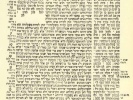
Bablyonian Talmud, Book 4: Tracts Pesachim, Yomah and Hagiga, tr. by Michael L. Rodkinson, [1918], at sacred-texts.com

Bablyonian Talmud, Book 4: Tracts Pesachim, Yomah and Hagiga, tr. by Michael L. Rodkinson, [1918], at sacred-texts.com
THIS volume contains three tracts, in order to maintain some uniformity in the size of the volumes, 1 whereas in former issues one subject required three volumes and another one volume, while in two instances each of two volumes treated of two different subjects; viz., three volumes being devoted to subject Sabbath (including Erubin), one volume to Passover, one to the Half-shekels (Shekalim--which were to be given in the beginning of each year) and New Year, one to the Day of Atonement (including also the Holocausts for the Altar). Of the three tracts now presented, Tract Succah treats of the Booth, Palm Branches, Citrons, etc., and specially appertains to the Feast of Tabernacles, the other two treating of the laws and regulations as to festivals in general; viz., Yom Tob (literally "Good Days") of all festivals, including also the New Year and Moed Katan (Minor Festivals) of the middle days between the first and seventh days of Passover and between the first and eighth days of Tabernacles.
As to the treatment of the semi-festivals, viz., Hanukka and Purim--the former is included in Tract Sabbath, Volume I., and the latter, which has a tract to itself, named "Megilah," or "Book of Esther," is to appear in the next and last volume of this section, and contains Taanith (the Regulation of Fast Days), Megilah (which is to be read while fasting), and, finally, Ebel Rabbathi (Great Mourning), which is also called "Sema'hoth" (Joys) for reasons which will be explained in our introduction to it.
We do not at present say more about the tracts of this section, as it is our intention to make further comment on them in our next volume.
NEW YORK, April, 1899.
v:1 Each tract, however, is paged separately, for the reason stated in Introduction to Vol. VI., p. xvi.